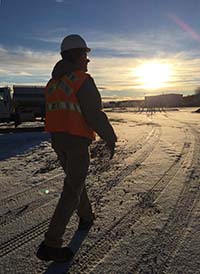
The Glennallen Response Base is located in Alaska’s Interior, a little over 100 miles north of Valdez. Originally designated as Pump Station 11, the facility was constructed as a response and maintenance base after it was decided that another pump station wasn’t necessary. Now, a small Alyeska team, supported by a focused and energetic Ahtna baseline crew, coordinates and carries out maintenance and prevention activities along the pipeline right of way, while maintaining a constant state of oil spill response readiness. Their accountable area stretches from south of Paxson all the way to the gate of the Valdez Marine Terminal.
“I wake up in the morning and my first priorities are the safety of our team and spill response preparedness,” said supervisor Jeff Streit, a TAPS veteran who traces his work history back to construction. “This area, we have it all. Mountains, fault lines, and rivers and streams, many of which drain directly into the Copper River. I think it’s some of the most challenging and complex geography on TAPS.”
Streit works hand in hand with Larry Huelskoetter, the Ahtna Superintendent and longtime Copper River basin resident.
“The (Ahtna) crews are skillful,” said Huelskoetter. “They go out into the elements at do important work safely. These individuals are connected to the area and it shows.”
The team uses a variety of tools and vehicles to accomplish their work, from airboats to tuckers, which provide access to remote areas of TAPS in the winter time. They also maintain staged equipment in locations along TAPS, which can be deployed to protect sensitive areas in the event of a spill.
“At the end of the day, our job is to make sure every inch of pipe is sound,” said Streit.
“And every inch of our employees is sound, too,” added Huelskoetter.
• Submitted by Alyeska Corporate Communications.